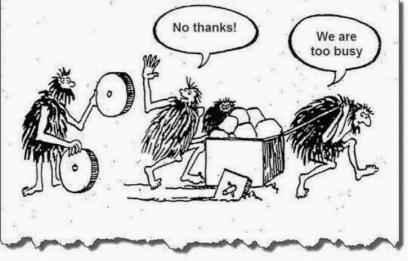May 9 2014
Making time for improvement
“How do you make time for improvements?” asked a manager on The Lean Edge. The anonymous questioner is self-described as experienced in Lean and currently CEO of a company in the outdoor sports industry, with employees who want time to climb, backpack, canoe, etc. This question brought forth an unusually brutal answer from usually mild-mannered Art Smalley, casting doubt on the questioner’s actual experience of Lean and telling him or her to exercise leadership.
I would not be so harsh. The situation in the CEO’s company is best described by this cartoon I found on Scott Simmerman’s site:

Getting out of this dysfunctional mode of operation is not obvious, and can be a challenge even for someone who has experienced Lean in a company that has been working on it for a few years.
While I have never seen it acknowledged in the literature, my own experience is that first-line managers — whether called supervisors, group leaders, or area coordinators — are the key agents for improvement activity. As part of management, they have the clout needed to get support from Maintenance, Engineering, and other support groups; from being on the first line, they are in direct contact with production operators and communicate with them daily. This puts them in a unique position to lead improvement projects, but the way their job is set up in many companies prevents them doing it.
In the Toyota system in assembly, the first-line managers are in charge of four to six teams of four to six operators each, which translates to a minimum of 16 operators and a maximum of 36, with the actual average being near the low end. When NUMMI was running, the figure was an average of one first-line manager for 17 operators. Contrast this with a situation I encountered in many manufacturing companies, where each first-line manager had 80 to 100 operators, and had no time for anything but expediting parts, keeping records, and disciplining rogue operators. The upper managers were proud of this situation, and described it as “Lean.” They didn’t think it was a good idea to have more first-line managers because they are “non-value added.”
I don’t presume to know whether this is the case in the questioner’s sporting goods company but, if it is, reinforcing first-line management is a good place to start, particularly if it can be done by internal transfers, for example by giving engineers the opportunity to try their hand at running production. It must also be clear that these new first-line managers, with fewer operators, are expected to spend 30% of their time on improvement.
Starting continuous improvement in an organization is a bootstrapping process. Pilot projects not only demonstrate value but free resources and develop skills that allow you to ramp up the activity. For this to happen, the selection of pilot projects is critical and here are some of the conditions they must meet:
- They must be few in number. An organization that is starting out in Lean may have the capacity to undertake two projects, but not ten.
- They must be within the area of responsibility of a single first-line manager, to avoid the complexity associated with involving multiple departments.
- Each one must have tangible, measurable improvements at stake, at least in quality and productivity. Otherwise, they will not be “pilots” of anything.
- They must be feasible with current skills of the work force.
- They must be opportunities to develop new skills.
- The target area must have a sufficient remaining economic life. If you plan to shut it down in six months, don’t bother improving it.
- The first-line manager must perceive the project as an exciting opportunity.
- …
Most “Lean initiatives” do not bother with such considerations. No wonder they fail.
May 31 2017
Flattening the Organization- Problably Not the Answer | Gregg Stocker
“One of the misconceptions about lean thinking is that it automatically leads to flattening the organization. Many people think that layers of management are always a bad thing and start removing layers as a way to empower employees, speed up decision-making, and improve innovation. While there is no shortage of organizations that suffer from too many layers, it should be noted that flattening does not necessarily lead to improved performance. Many organizations that flattened their structures have experienced little more than burned out managers, frustrated employees, and high turnover.”
Sourced through Lessons in Lean
Michel Baudin‘s comments: For the second time in a week, I am clipping a post from Gregg’s blog but I can’t help it if I find his writings worth sharing. In my experience, “flattening the organization” is particularly harmful on the shop floor. I have heard managers brag about their structure being “lean” because they had only 1 supervisor for 100 operators. This isn’t what Toyota does in car assembly, where operators work in teams of 4 to 6 and you have a first-line manager for 4 to 6 teams. This means that the number of operators for a first-line manager ranges from 16 to 36, with a mean that is actually around 17. This low number is designed to allow the first-line managers to help operators in their professional development and to lead improvement projects. A supervisor with 100 direct reports can do neither.
#LeanManagement, #First-LineManager, #ShopFloor, #ContinuousImprovement
Share this:
Like this:
By Michel Baudin • Blog clippings 0 • Tags: Continuous improvement, First-line manager, Lean management, Shop floor